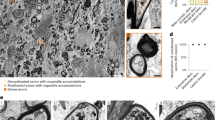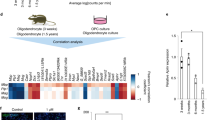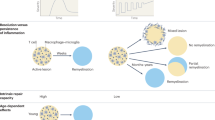Abstract
Several lines of evidence suggest that tyrosine phosphorylation is a key element in myelin formation, differentiation of oligodendrocytes and Schwann cells, and recovery from demyelinating lesions1,2,3,4,5,6,7. Multiple sclerosis is a demyelinating disease of the human central nervous system, and studies of experimental demyelination indicate that remyelination in vivo requires the local generation8, migration or maturation9 of new oligodendrocytes, or some combination of these. Failure of remyelination in multiple sclerosis could result from the failure of any of these processes or from the death of oligodendrocytes. Ptprz encodes protein tyrosine phosphatase receptor type Z (Ptpz, also designated Rptpβ), which is expressed primarily in the nervous system but also in oligodendrocytes10,11, astrocytes and neurons12. Here we examine the susceptibility of mice deficient in Ptprz to experimental autoimmune encephalomyelitis (EAE), a model of multiple sclerosis. We observe that mice deficient in Ptprz show impaired recovery from EAE induced by myelin oligodendrocyte glycoprotein (MOG) peptide. This sustained paralysis is associated with increased apoptosis of mature oligodendrocytes in the spinal cords of mutant mice at the peak of inflammation. We further demonstrate that expression of PTPRZ1, the human homolog of Ptprz, is induced in multiple sclerosis lesions and that the gene is specifically expressed in remyelinating oligodendrocytes in these lesions. These results support a role for Ptprz in oligodendrocyte survival and in recovery from demyelinating disease.
This is a preview of subscription content, access via your institution
Access options
Subscribe to this journal
Receive 12 print issues and online access
$209.00 per year
only $17.42 per issue
Buy this article
- Purchase on Springer Link
- Instant access to full article PDF
Prices may be subject to local taxes which are calculated during checkout




Similar content being viewed by others
References
Umemori, H. et al. Stimulation of myelin basic protein gene transcription by Fyn tyrosine kinase for myelination. J. Neurosci. 19, 1393–1397 (1999).
Vartanian, T., Goodearl, A., Viehover, A. & Fishbach, G. Axonal neuregulin signals cells of the oligodendrocyte lineage through activation of HER4 and Schwann cells through HER2 and HER3. J. Cell Biol. 137, 211–220 (1997).
Garratt, A.N., Voiculescu, O., Topilko, P., Charnay, P. & Birchmeier, C. A dual role of erbB2 in myelination and in expansion of the Schwann cell precursor pool. J. Cell Biol. 148, 1035–1046 (2000).
Fernandez, P.A. et al. Evidence that axon-derived neuregulin promotes oligodendrocyte survival in the developing rat optic nerve. Neuron 28, 81–90 (2000).
Wallace, M.J. et al. Neuronal defects and posterior pituitary hypoplasia in mice lacking the receptor tyrosine phosphatase PTPσ. Nat. Genet. 21, 334–338 (1999).
Peretz, A. et al. Hypomyelination and increased activity of voltage-gated K+ channels in mice lacking protein tyrosine phosphatase ε. EMBO J. 19, 4036–4045 (2000).
Elchebly, M. et al. Neuroendocrine dysplasia in mice lacking protein tyrosine phosphatase σ. Nat. Genet. 21, 330–333 (1999).
Keirstead, H.S. & Blakemore, W.F. Identification of post-mitotic oligodendrocytes incapable of remyelination within the demyelinated adult spinal cord. J. Neuropathol. Exp. Neurol. 56, 1191–1201 (1997).
Sim, F.J., Zhao, C., Penderis, J. & Franklin, R.J. The age-related decrease in CNS remyelination efficiency is attributable to an impairment of both oligodendrocyte progenitor recruitment and differentiation. J. Neurosci. 22, 2451–2459 (2002).
Canoll, P.D., Petanceska, S., Schlessinger, J. & Musacchio, J.M. Three forms of RPTPβ are differentially expressed during gliogenesis in the developing rat brain and during glial cell differentiation in culture. J. Neurosci. Res. 44, 199–215 (1996).
Ranjan, M. & Hudson, L.D. Regulation of tyrosine phosphorylation and protein tyrosine phosphatases during oligodendrocyte differentiation. Mol. Cell Neurosci. 7, 404–418 (1996).
Shintani, T., Watanabe, E., Maeda, N. & Noda, M. Neurons as well as astrocytes express proteoglycan-type protein tyrosine phosphatase ζ/RPTPβ: analysis of mice in which the PTPζ/RPTPβ gene was replaced with the LacZ gene. Neurosci. Lett. 247, 135–138 (1998).
Raine, C.S. The Norton Lecture: a review of the oligodendrocyte in the multiple sclerosis lesion. J. Neuroimmunol. 77, 135–152 (1997).
Harroch, S. et al. No obvious abnormality in mice deficient in receptor protein tyrosine phosphatase β. Mol. Cell. Biol. 20, 7706–7715 (2000).
Liu, X., Mashour, G.A., Webster, H.F. & Kurtz, A. Basic FGF and FGF receptor 1 are expressed in microglia during experimental autoimmune encephalomyelitis: temporally distinct expression of midkine and pleiotrophin. Glia 24, 390–397 (1998).
Sommer, I. & Schachner, M. Monoclonal antibodies (O1 to O4) to oligodendrocyte cell surfaces: an immunocytological study in the central nervous system. Dev. Biol. 83, 311–327 (1981).
Breitschopf, H., Suchanek, G., Gould, R.M., Colman, D.R. & Lassmann, H. In situ hybridization with digoxigenin-labeled probes: sensitive and reliable detection method applied to myelinating rat brain. Acta Neuropathol. 84, 581–587 (1992).
Acknowledgements
G.C.F. is currently supported by the US National Multiple Sclerosis Society, J.R. is supported by the US National Institute of Health and National Multiple Sclerosis Society and S.H. was supported in part by Fédération pour la Recherche Medicare et l'association Contre le Cancer.
Author information
Authors and Affiliations
Corresponding author
Ethics declarations
Competing interests
The authors declare no competing financial interests.
Rights and permissions
About this article
Cite this article
Harroch, S., Furtado, G., Brueck, W. et al. A critical role for the protein tyrosine phosphatase receptor type Z in functional recovery from demyelinating lesions. Nat Genet 32, 411–414 (2002). https://doi.org/10.1038/ng1004
Received:
Accepted:
Published:
Issue Date:
DOI: https://doi.org/10.1038/ng1004
This article is cited by
-
Astrocyte Support for Oligodendrocyte Differentiation can be Conveyed via Extracellular Vesicles but Diminishes with Age
Scientific Reports (2020)
-
Loss-of-function of PTPR γ and ζ, observed in sporadic schizophrenia, causes brain region-specific deregulation of monoamine levels and altered behavior in mice
Psychopharmacology (2017)
-
Analysis of microRNA and Gene Expression Profiles in Multiple Sclerosis: Integrating Interaction Data to Uncover Regulatory Mechanisms
Scientific Reports (2016)
-
Protein tyrosine phosphatase ζ enhances proliferation by increasing β-catenin nuclear expression in VHL-inactive human renal cell carcinoma cells
World Journal of Urology (2013)
-
The cerebrospinal fluid proteome in HIV infection: change associated with disease severity
Clinical Proteomics (2012)



